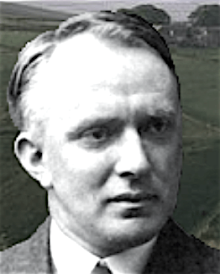
Arthur Joseph Penty [also known as Arthur J. Penty] was born in York, England on 17 March 1875. Both his father, Walter Green Penty (1852-1902), and his brother, Frederick Thomas Penty (1879-1943) were architects. He was articled to his father in York, Yorkshire, England, in 1890 and stayed with him as his assistant until 1897 when the two formed a partnership, W.G. & A.J. Penty, architects. The partnership was dissolved following Penty senior's death five years later and from 1902 onwards A. J. Penty worked as an assistant to a succession of architects including Harry Dighton Pearson (1867-1925), William Thomas Mynors Walker (1856-1930), Fred Rowntree (1860-1927), Francis William Bedford (1866-1904) and Raymond Unwin (1863-1940).
Works by Penty included Moorfield in Haslemere, Surrey; Kingsend in Ruislip in Middlesex; Aldersyde in York; Dairy Hall in York; and Dunollie in Scarborough, Yorkshire. At the end of World War Two, Penty collaborated with the architects Fred Rowntree and Charles Sydney Spooner (1862-1938) in a scheme to employ Belgian refugees in the prefabrication of buildings in Belgium.
In addition to his work as an architect, Penty also designed furniture. Photographs of an oak dresser and an oak bookcase designed by Penty are illustrated in 'The Studio Yearbook of Decorative Art 1906 (pp.53, 67). Penty's exhibited at the Royal Academy in London in 1902-03 and participated in the 7th (1903 8th (1906) exhibitions of the Arts & Crafts Exhibition Society in London. [His surname is misspelt Plenty in the catalogue of the 1903 exhibition]
In c.1904 Penty and the architect Charles Sidney Spooner (1862-1938) established Elmdon & Co., a furniture workshop with premises at 1 Ravenscourt Park, Hammersmith, London. The company largely, or possibly exclusively, produced "moderately priced" furniture. They exhibited at the Alpine Club in London in 1905. They also participated in the eighth exhibition of the Arts & Crafts Exhibition Society at Grafton Galleries in London in 1906.
Penty, was a man with strong political convictions. He was a member of the Fabian Society and the author of several books and articles on guild socialism and distributism.
Penty was elected a Licentiate of the Royal Institute of British Architects (LRIBA) in 1911 and a member of the Art Workers Guild (AWG) in 1925.
His address was given as Effingham House, Arundel Street, Strand, London in 1902, 25 Denning Road, Hampstead, London in 1911 and 1914, and 66 Strand-on-Green, Chiswick, London in 1926. Penty died in Isleworth, Middlesex on 19 January 1937.
"Alderyde", York: " Dunollie," Scarborough; Davy Hall, York; Noonfield, Haslemere; Kingsaid, Ruislip; Elm Banks, York. [Source: Who's Who in Architecture 1914]
Moorfield, Haslemere; Kingsend, Ruislip; Aldersyde, York; Dairy Hall, York; Dunollie, Scarborough. [Source: Who's Who in Architecture 1926]
Directory of British Architects 1834-1914. Compiled by Antonia Brodie, et al. Volume 2: L-Z. London; New York: British Architectural Library, Royal Institute of British Architects/Continuum, 2001
Gray, A. Stuart. Edwardian architecture: a biographical dictionary. London: Gerald Duckworth & Co., Ltd., 1985
Grosvenor, Peter C. The Medieval Future of Arthur Joseph Penty: The Life and Work of an Architect. Norfolk, Va.: IHS Press, 2008
‘Obituary’. The Builder vol. 152, 29 January 1937 p. 273
‘Obituary’. RIBA Journal 6 March 1937 pp. 466-467
Thistlewood, David. ‘A. J. Penty (1875-1937) and the legacy of 19th-century English domestic architecture’. Journal of the Society of Architectural Historians vol. 46, no. 4, December 1987 pp. 327-341
Who's Who in Architecture 1914. London: Technical Journals Ltd., 1914
Who's Who in Architecture 1926. Edited by Frederick Chatterton. London: The Architectural Press, 1926